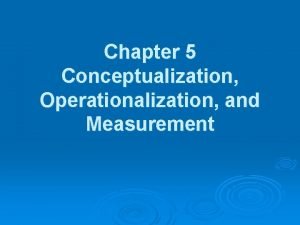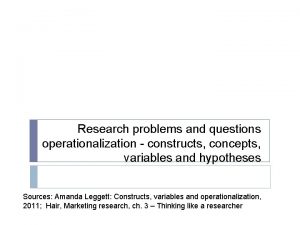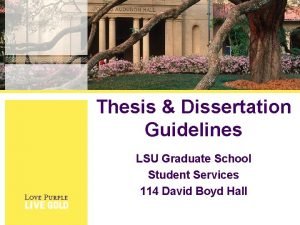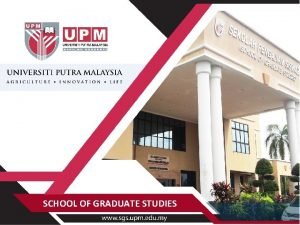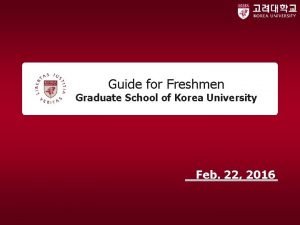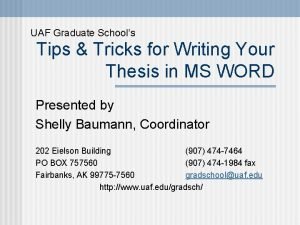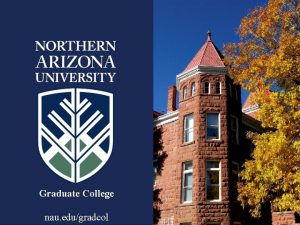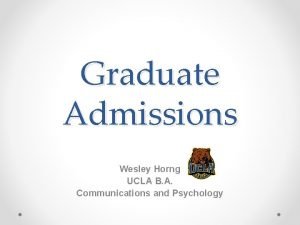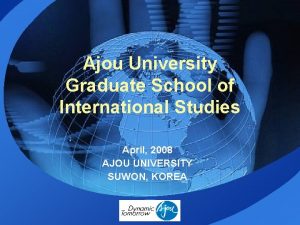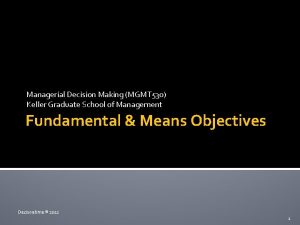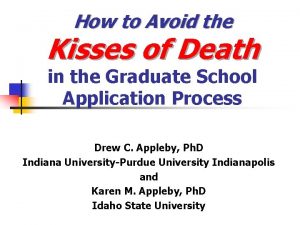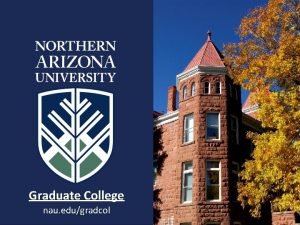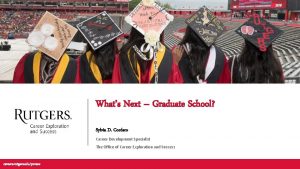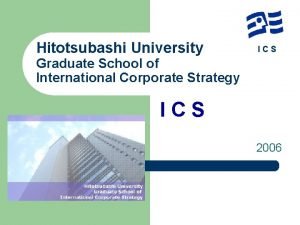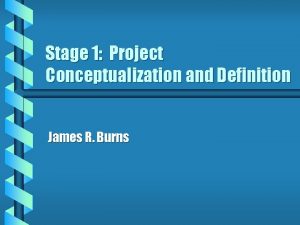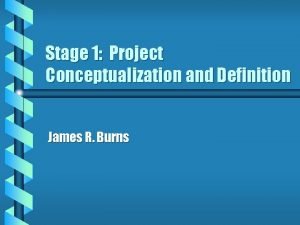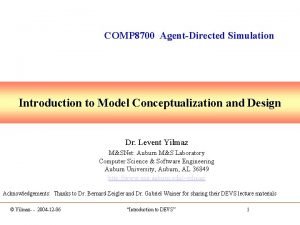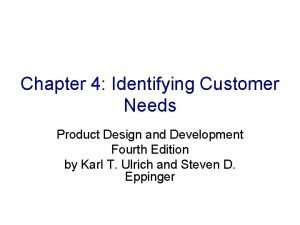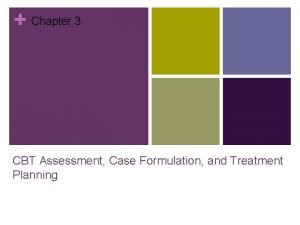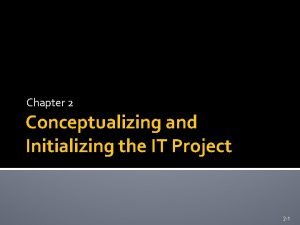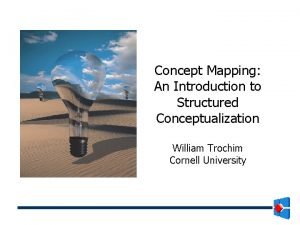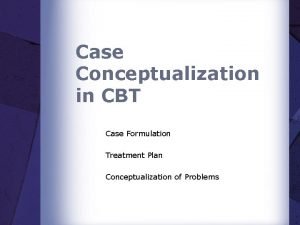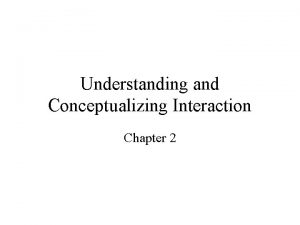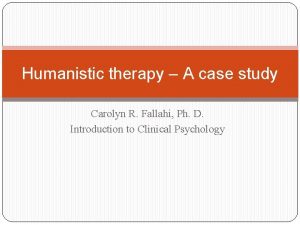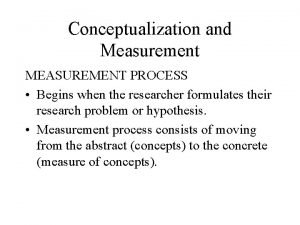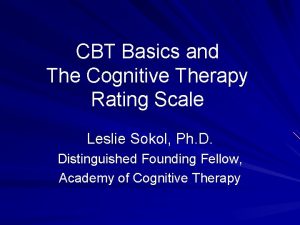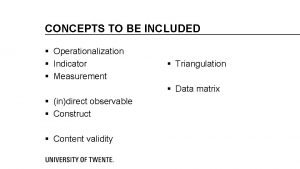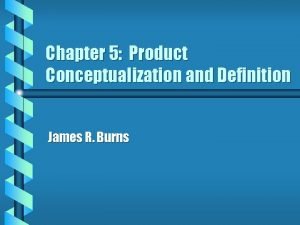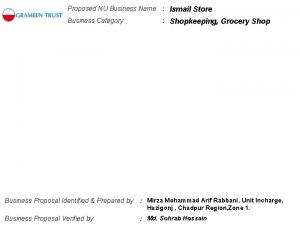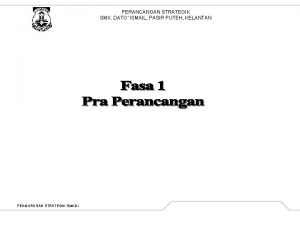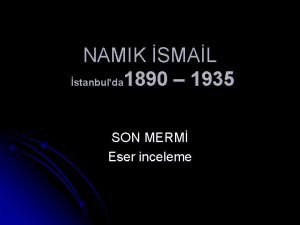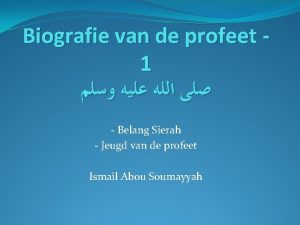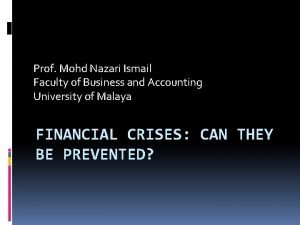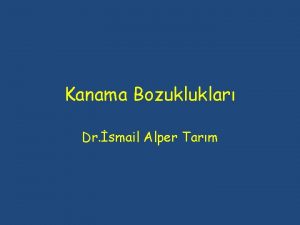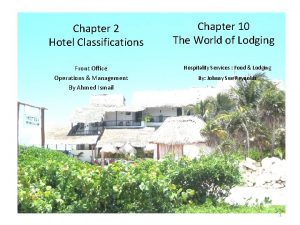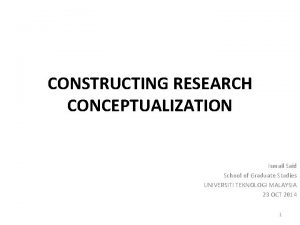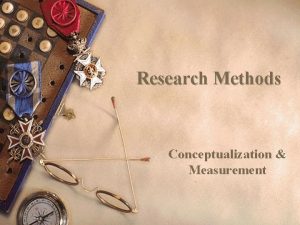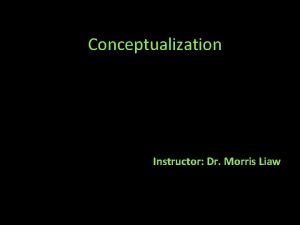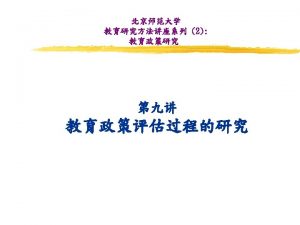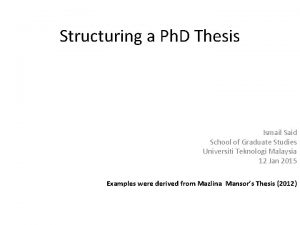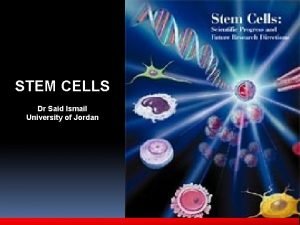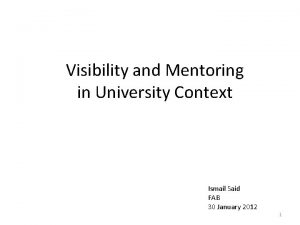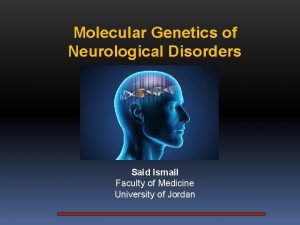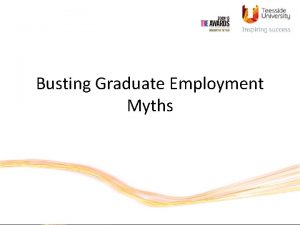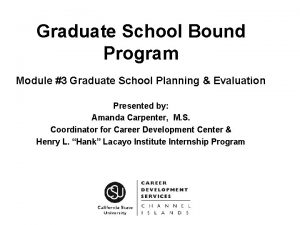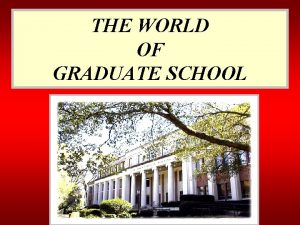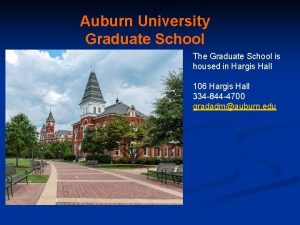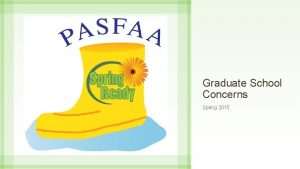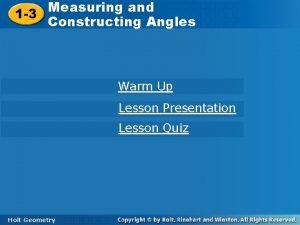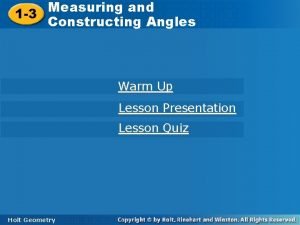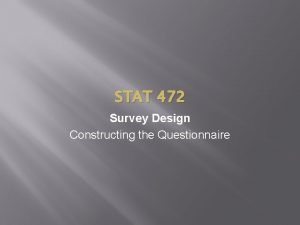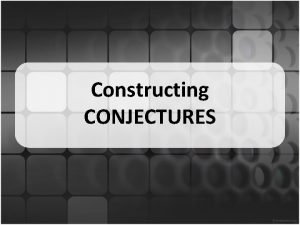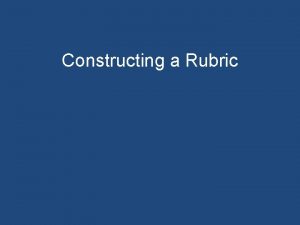CONSTRUCTING RESEARCH CONCEPTUALIZATION Ismail Said School of Graduate















































- Slides: 47

CONSTRUCTING RESEARCH CONCEPTUALIZATION Ismail Said School of Graduate Studies UNIVERSITI TEKNOLOGI MALAYSIA 23 OCT 2014 1

What we get at end of this workshop? 1. To learn the meaning of research conceptualization; 2. To construct a flowchart of a thesis conceptualization; and 3. To learn the importance of literature review in the making of a thesis. 2

Part 1 The Journey 3

The Journey CP 1 CP 2 CP 3 JP 1 CP 4 JP 2 JP 3 Day 1 Year 1 Research Conceptualization; Preparation of Research Proposal; Literature Review, Problem Definition Year 2 Data collection and analysis Year 3 Thesis writing Vivavoce Submit thesis

Complex to Simple • Problem conceptualization, theoretical framework, research methodology should be complex. • But, your conclusion should be simple to comprehend.

Part 2 What is a literature review? What is research conceptualization? 6

What is a literature review? • Literature is a body of information that has conceptual relevance for a particular topic of inquiry. • A critical look at the existing research. • It is not a summary or annotated bibliography. • It is synthesizing a subject from a set of previous studies in your own stance. • Evaluate the work, show the relationships between different work, and show it relates to your work. 7

2 Overview Model of Architectural Content Quality Model of Behavioral-based 1. Model of Architectural Simulation Quality 2. Model of Behavioralbased Simulation Modeling using- AI, 70 s 80 s understandingbehavior, crowd of pedestrian, Limited- computer power Conway Fruin cellular automata, Development of- way finding alg. Watanabe Behavior & environmental design Understanding Crowd Pedestrian movement AI with reasoning model, model based on dynamic vars. 90 s 00 s Terzepoulos Palechano Synthetic perception Reynolds Okazaki Handerson More modeling, AI using physics, emergence, cognitive models Decision Support sys. Behavior& Renault Particle & automata flow-based sim. Introducing AI Rao & Georgeff Interaction & emotion-based sys. Way-finding Kuwahara Ortony Hiido Yoshida Thalmann Watanabe Reasoning model Social & Ebihara cognitive Tyrell emergence Crowd modeling AI Crowd dynamics Mussee Monzani Bates Thalmann Matsuda 8 /120

What is a literature review? • Literature review is a process of searching empirical findings and methodology of study from previous research from journals, textbooks, theses, magazines, archives, and personal communications. • It is a paragraph or a set of paragraphs explaining what had been studies, what is area to be further studied to add a set of knowledge to the reviewed pool of knowledge. 9

What is a literature review? • A literature review is a piece of discursive prose. • Organize the literature review into sections that present themes or identify trends, including relevant theory. • First example: 1. Environmental responses include a complex interaction of affective and cognitive responses to environmental stimuli (Kaplan, 1987; Nasar, 1994; Rapoport, 1977; Ulrich, 1983; Zajonc & Markus, 1982). 10

Discursive prose: The challenges of the public places in redevelopment of historic urban area (Nor Zalina, 2011) • The modernization movement in Malaysia started in the late 1970 s and early 1980 s, and by mid-1990 s, Malaysia succeeded in developing its economy. However the physical characters of the city especially the old and historical part, are somewhat received less attention which finally mess up the image, form and character of cities in many states. Until the year 2004, 181 buildings and monuments located in urban area were listed by the Malaysian Heritage Department since early 1980, however not a single historical site was listed so far. 11

Third Example: RESEARCH UNDERPINNING q Public space facilitates sense of community and growing the likelihood of social interaction (Gehl, 2001; Kim and Kaplan, 2004; Carmona et al. , 2008). q Kang (2006) agreed that access to public space had a higher degree of social cohesion and community engagement. q However, Chow and Chan (2008), and Haung, (2009) argue that people have higher positive attitudes about sharing knowledge, ideas and possessions with those whom they had established a handy relationship and strong social cohesion q On this note, there exist possible contributions of public space towards knowledge sharing and human social networking (Figure 1. 1). Social interaction Public space Knowledge sharing Social cohesion Figure 1. 1: Public space and knowledge sharing relationship IMPACT OF PUBLIC SPACE ON KNOWLEDGE SHARING IN SCIENCE CITIES 13 th September, 2013

FECTS OF GREENSPACE CHARACTERISTICS ON URBAN RESIDENTS’ SOCIAL INTERACTION Content Introduction Contribution Results R. Background & R. Underpinning & Framework Researc h Desig n Aim R. Obj 2 R. Obj 3 Analyses Meth ods De s In crip fe re tive n St tial & SP ats S SS. & EM Co AM rre O la S tio n R Researc h R. Obj 1 et . M R. Issues R. Gap & Findings Conclusion gy o l do ho Survey Behavioral Unobtrusive Site Survey Questionnaire Mapping Observation s 2

What is a literature review? • Second example: In general, aesthetic response to building attributes such as façade colour is considered a complex interface involving affective appraisal and cognitive judgements (Nasar, 1994; Stamps, 2000). Source: O’Connors (2008): Façade colour and aesthetic response: Examining patterns of response within the context of urban design and planning policy in Sydney 14

What is a literature review? Demonstrate skills in two areas: • information seeking: the ability to scan the literature efficiently, using manual or computerized methods, to identify a set of useful articles and books • critical appraisal: the ability to apply principles of analysis to identify unbiased and valid studies. 15

An example of a synthesis • Studies in paediatric nursing found that stress in the ward that caused stress on children are (i) confinement due to limited space for free movement or play, (ii) seeing complex and strange medical apparatus, (iii) staying next to strangers, and (iv) isolation or separation from families and friends (Lindheim et al. , 1972; Lansdown, 1996; Lau, 2002; Haiat et al. , 2003). 16

An example: Impact of Green infrastructure on residents’ wellbeing in small town • Disciplines: (1) Urban ecosystem, (2) Urban design, (3) Arboriculture, (4) Environmental psychology , (5) Community health, (6) Environmental planning, and (7) Landscape architecture. • Urban ecosystem: Ecological network on quality of life • Urban design: Uses of parks and green spaces pertaining to social values • Environmental psychology : Sense of community and social interaction and pedestrianism 17

What is a literature review? • A literature review exists only after the general material has been arranged into a coherent system, one that has been customized to fit the research question (Groat and Wang, 2002). 18

Exercise 1 • Play allows opportunities for physical, emotional, cognitive and social growth. • Play is a child’s natural medium for self-expression, experimentation and learning. • Play is pleasurable, spontaneous and creative interaction of a child with physical elements and people in a geographic space. • Play enables children to express aggression and buried feelings. • Play is voluntary, self-initiated by the individual. • Play is locomotion of a child through which he gathers information by temporal scanning the environment and social cognition with others. • Play is a mean for children to attain stimulation and feedback from the surroundings. 19

Part 3 Why doing a literature review? 20

Why doing a literature review? A rigorous literature search and review affords you: • Finding a research problem • Defining research gap and situating a research with current status quo of a subject • Finding underpinnings and developing framework of study • Searching for research method, research design or research approach, and parameters of study 21

Finding a research problem • Through rigorous readings, one begins to see what the research concern of a subject is. • It means that a review of previous studies help research to view a broad and integrated perspective. • Find meaning of parameters 22

Research Report Behavioral-based Model & Simulation For Spatial Analysis in Architectural Design by Aswin Indraprastha Supervisor Prof. Dr. Michihiko Shinozaki Modified to be presented at Green Innovation Research Group (GIRG) Lecture, Universiti Teknologi Malaysia, 18 July 2012 23 /120

1 Introduction Objective & Goals Limit of study Originality Contribution 24 /120

2 Overview Model of Architectural Content Quality Model of Behavioral-based 1. Model of Architectural Simulation Quality 2. Model of Behavioralbased Simulation Modeling using- AI, 70 s 80 s understandingbehavior, crowd of pedestrian, Limited- computer power Conway Fruin cellular automata, Development of- way finding alg. Watanabe Behavior & environmental design Understanding Crowd Pedestrian movement AI with reasoning model, model based on dynamic vars. 90 s 00 s Terzepoulos Palechano Synthetic perception Reynolds Okazaki Handerson More modeling, AI using physics, emergence, cognitive models Decision Support sys. Behavior& Renault Particle & automata flow-based sim. Introducing AI Rao & Georgeff Interaction & emotion-based sys. Way-finding Kuwahara Ortony Hiido Yoshida Thalmann Watanabe Reasoning model Social & Ebihara cognitive Tyrell emergence Crowd modeling AI Crowd dynamics Mussee Monzani Bates Thalmann Matsuda 25 /120

2 Overview Content 1. Model of Architectural Quality 2. Model of Behavioralbased Simulation More developments of modeling on the behaviors of the crowd, its characteristics that lead to solve real-life problems 26 /120

Theoretical Review Rebuilding city identity through the use of urban morphology (Widya, 2013) • Some studies have underlined the use of physical urban elements to create, rebuild and maintain identity for urban sustainability – Using physical identity characteristic and hidden feature of traditional pattern (Tavakoli, 2010) – Using architecture for understanding the forming of city identity (Doucet, 2007; Makas, 2007) – Using the urban morphology to investigate the architecture and urban character (Elsheshtawy, 2008) – Using the people-place relationship (Gospodini, 2004, 2006; Lewicka, 2008)

Situating a research with current status quo of a subject Urban Morphology Conzen, 1960; Lynch, 1960; Kostof, 1991; Wikantyoso, 1997; Hillier, 2001; Ikaputra, et. Al, 2000; Fattahi and Kobayashi, Urban 2009 a, 2009 b Boblic, 1990; Hall, 1997; Purwanto, 2005; Hanh, 2006; Hara, et. al (2008) Tuan, 1974; Steele, 1981; Altman and Low, 1992; Hummon, 1992; Jackson, 1994; Cross, 2001; Guillani, 2003; Willian and Vaske, 2003; Smaldone, 2006; Handal. 2006; Beidler, 2007; Hernandez, 2007; Brown and raymond, 2007; Watson and Bentley, 2007; White et. al, 2008; Liu, 2009; Raymod et. al, 2010; Najafi and Kamal, 2011 Identity Environmental Psychology Place Familiarit y Sense of Place Schuller, 1898; Geisler, 1918; Whitby, 1951; Conzen, 1960; Muratori, 1960; Hillier aand Hanson, 1984; Forties; 1989; Kropt, 1996; Hall, 1997; Levy, 1999; Canigia, 2001; Jiang and Claramunt, 2002; Chapman, 2006; james and Bound, 2009; Tian et. al, 2010; Topcu and Kubat, 2012 Element Urban Structur e Change Urban Settin g Inn, 2004; Gospodini, 2004, 2011; Doralti, 2004; Watson, 2006; Plaza, 2006, 2008; Butina, 2006; Niebrzydowski, 2007; Novickas, 2007; Lewicka, 2008; Handal, 2009; Chen, 2011; Sainz, 2012 Urban Remind er Place Rebuilding Character City Identity Authentic ity City's Place Identity of Place Attachment City Marketing Cultur e Image of the city Rodwel, 2007; Kolzlowski and Bowen, 1997; Sevinc, 2009; Wei and Kiang, 2009; Whitehand Gu, 2010; Albert and Hanzen, 2010; Hillier, 2001 Whitehand Morton, 2004; Rapoport, 2004; Samant, 2004; Tweed and Sutherland, 2007; Smith, 2008; Rabady, 2010; Ragab, 2011, Kim, 2011 Conservation Preservation

Defining research gap • Once a problem is encountered, a researcher foresees the gap of study that he or she would like to bridge through empirical investigation. • A review of literature can ensure a researcher to define his or her study gap by analyzing what previous studies had examined and what have not been investigated. 29

Rebuilding city identity through the use of urban morphology (Widya, 2013) • In urban morphology study, the discussion on urban character is dominated by the studies on the inland city where the character of historical area is obviously persistent in modern context. • There is a lack of discussion on – The river as the elements that form the urban character of a city – The urban character at historical riverside area • The previous studies on Palembang riverside area are dominated by the discussion on the structure of the settlement such as the change and the typology. • There is a lack on the discussion on the morphology of riverside settlement and its relation of the identity of Palembang as a river city 30

Defining the meaning of parameters/domains/variables/dimensions metertu Determinants Morphology Properties Perception toward the place Psychological effect Parameters Morphological component Morphological region Morphological development Physical and spatial elements (Building and space) Key element Place character City’s form (vista) Collective memory Cultural expression Place attachment Sense of Place Special place Responses on development plan

Type of environment Author/Year Major findings Playground Pellegrini (1990), Nowakowski and Charytonowicz (2007). Children’s playground behavior varies according to location on the playground and gender of the child. Behavior differences on different playgrounds may have been due to the age of children, type of playground, or the interaction between age and playground type. Playground provides opportunity to learn and develop social skills. Neighborhood Francis and Lorenzo (2002), Huttenmoser (1995), Jutras (2009), Karsten and Vliet (2006), Page et al. (2009), Heft (1988), Veitch et al. (2008). Child participation is a major area of environmental design proactive and research today. Unsuitable living surroundings influence on longer period of parental accompaniment to children. Physical activity and independent mobility are likely to be influenced by the type of neighborhood as well as perceptions of that neighborhood. Form-based description of environment does not change regarding with individual development, but affordances of environment will be changeable with different conditions of individuals. Home-school Way Osborne (2005), Ahmadi and Taniguchi (2007), Orsini and O’Brien (2006), Rissotto and Tonucci (2002), Yeung et al. (2008), Mc. Millan (2007). Walking travel mode creates opportunities for children to explore their environment and know it better. The categories of motivations for cycling were identified as: enjoyable (fun), better than alternatives (fast), and healthy (fit). The children who have more independent mobility have more detailed and complete environmental knowledge to represent their routes. The factors which influence on children’s active transportation comprise of children’s age, children’s fitness, obesity, traffic safety, distance and criminal safety. The urban forms are the most significant factors in parental making decision about their children’s travel mode to school but not as the sole factor. Forest / Natural Environment City / Suburb Smith et al. (2008), The environment scale and size, and position of features in it affects on children’s sensitivity and Fjortoft and Sageie preference for spatial cues. (2000). Diverse natural landscapes have suitable composition and structures to meet children’s needs for different play functions. Vliet (1983), Kytta (2002). Children’s travel modes are different in city and suburb because of distance, and the biggest citysuburban difference was in walking. Accessibility to the natural environments creates the highest affordances because of having a rich set of affordances. 32

Finding underpinning and developing framework of study • An underpinning is a theory, concept or a theoretical framework that forms a base for a research to take a stride to fulfill the research objectives. • E. g. Theory of Affordance (Gibson, 1979) • E. g. Theory of Place Attachment (Chawla, 1992) 33

Find meaning of parameters 1) E. g. of urban planning study Participants’ knowledge, views, understandings, interpretations, experiences and interactions 2) E. g. of landscape planning study in green infrastructure diversity, naturalness, and coherence 3) E. g. of urban design study on open space place familiarity, place belonginess, place attachment 34

PLACE MAKING AND MEANING OF PADANG AS A PUBLIC PLACE IN HISTORIC CITIES OF MALAYSIA Nor Zalina Harun (PB 073042) Ph. D Candidate, Universiti Teknologi Malaysia

Research Gap But amid the resurgence of interest in such researches, literature review indicates that: 1. Very little, attempts at bringing public space contribution to the identity of place and people. Attention was often concentrated on single or dual component of place (physical and activities) with not much is done to integrate whole components (physical+activities+meaning) ; the interdisciplinary nature between urban design and environmental psychology. 2. Although research on both disciplines is recorded in the western countries, it is still minimal in developing countries including Malaysia. 3. Lack of theoretical discussion on the process of place meaning beyond the widely acknowledged three levels of meaning; low, moderate and high levels. 4. The roles of place attachment as a component that give place meanings has not been adequately explored. 5. Even though place literature suggests that place attachment may imply a deep concern about place however there is not much is known about how changes on favorite places affects or disrupts people.

Research underpinning • Place making: The process of making good place by reviewing substantive dimension in urban design such as urban design, social, visual and functional (Carr et al. , 1992; Tibbalds, 1992; Carmona, 2003; Carmona and Tiesdell, 2007). • Place meaning: A key to the importance of place subjected to knowledge and experience people have within it (Relph, 1976; Green, 1999; Gustafson, 2001; Manzo, 2005). • Place attachment: Affective bond or link between people with particular setting (Low and Altman, 1992; Hidalgo and Hernandez, 2001; Walker and Ryan, 2008).

FECTS OF GREENSPACE CHARACTERISTICS ON URBAN RESIDENTS’ SOCIAL INTERACTION Research Underpinning Research Framework Underpinnings Social Cognitive Theory Biophilia Hypothesis 8

39

40 EFFECTS OF EXPERIENTIAL CONTACTS WITH GREEN INFRASTRUCTURE ON WELL-BEING OF RESIDENTS IN A SMALL TOWN Mazlina Mansor (PB 073016) Ph. D Candidate Supervisor: Ismail Said Faculty of Built Environment, Universiti Teknologi Malaysia 15 November 2010

OBJECTIVES & R. QUESTIONS OBJECTIVE 1: To investigate the presence of diversity, naturalness, coherence and additional attributes that forms experiences of a green infrastructure network in a small town. KEY RQ 1: What makes green infrastructure network in a town possible for the residents to physically and visually access it? SUBSIDIARY QUESTIONS: a)What are the types of green infrastructure that can be found in urban green environment? b)How is the green infrastructure in Malaysian towns distributed? Does green infrastructure network exist in Taiping? c)How do residents feel about the properties and attributes of green infrastructure which include diversity, naturalness, coherence and other additional attributes in the town? OBJECTIVE 2: To identify uses and experiences that residents make of the green infrastructure and feelings that they have towards the properties and attributes. KEY RQ 2: How do properties and attributes of the green infrastructure assist the residents’ experiential contacts with nature and how do they affect their well-being? SUBSIDIARY QUESTION I): How does the green infrastructure network contribute to urban residents’ experiences? Do the majority of the residents utilise green infrastructure as their everyday setting? What are the opportunities it offers to the residents? What are the levels of the residents’ familiarity of the green infrastructure? OBJECTIVE 3: To determine the effects of experiential contacts with the green infrastructure network, and the relationships to wellbeing of residents, physically, cognitively and socially. OBJECTIVE 4: To propose a conceptual model eliciting the interrelationships of residents’ experiential contacts with the green infrastructure network to physical, cognitive and social wellbeing. HYPOTHESIS: Ho: Physical, cognitive and social well-being of the residents is independent to the properties and attributes of the green infrastructure. Hı: Physical, cognitive and social well-being of the residents is dependent on properties and attributes of green infrastructure. SUBSIDIARY QUESTION 2): How do the properties and attributes of green infrastructure network affect physical, cognitive and social experience and well-being of the residents? How do the residents benefits from their experiences in the green infrastructure? Is there a significant difference of the effects of visiting different green infrastructure on well being of the residents? How does green infrastructure network affect physical experience and wellbeing of the residents? What are the residents’ feelings towards the attributes of the green infrastructure? How does it affect their cognitive experience and performance? Do the residents develop a sense of attachment (cognitive effects) to the green spaces? How does green infrastructure affect residents’ social experience and wellbeing? Which attributes of the green infrastructure have a strong influence on physical, cognitive and social well-being of the residents? 4 1

42 OPERATIONAL DEFINITIONS Green infrastructure network - A composite of the green open spaces that is linked by streets, waterways and drainages encircling and connecting urban areas, at all spatial scales – an interconnected system of green infrastructure that is diverse, natural, coherent, clean, well maintained and equipped with facilities. Experiential contacts - Expression of emotional feeling from viewing, being and actively engaging in activities in a green infrastructure. Well-being –An inner state of wellness including physical, mental and emotional state of consonance and from social contacts which exists in a healthy environment. Small town – a town under the category of major settlement or minor growth centre within the population of 10, 000 to 100, 000.

UNDERPINNINGS a) Evolution-based Theory i) 1) PERCEPTUAL THEORIES Habitat specific • Savanna, Forest and Grassland-woodland Hypotheses. ii) Non-habitat specific • Prospect-refuge Theory (Appleton, 1975) • Landscape Preference Theory (Kaplan and Kaplan, 1982, 1989) • Biophilia Hypothesis (Wilson, 1984; Kellert and Wilson, 1993) “People have a more general innate bond with nature. Respond of people is in favour of natural settings than that of urban or man-made. ” “The innately emotional affiliation is a fundamental component of building and sustaining good health” b) Cultural Preference Theory • Topophilia (Tuan, 1974) “Human-nature relationships are predominantly dependent on the cultural background and personal attributes e. g. gender, occupation, hobbies, academic background. ” This study support mixture of these theories – responses to green infrastructure are innate as well as challenged and changed by cultural influences and experiences. 2) FRAMEWORKS that support the perceptual theories derived from urban ecosystem, conservation biology, landscape ecology, urban design, environmental planning and landscape architecture disciplines i. e. Tzoulas et al. , 2007; Pickett & Cardenasso, 2008. 43

INTERRELATIONSHIPS OF THE PARAMETERS Parameters that affect the link between cause and outcome parameters (from psychophysical procedures) Dependent parameters (PHYSIOLOGICAL EFFECTS) Independent parameters PHYSICAL DETERMINANTS PROPERTIES AND ATTRIBUTES: Diversity, naturalness, coherence & additional attributes (cleanliness, maintenance, facilities) EXPERIENTIAL CONTACTS viewing in & out, being in & active engagements: kinetic-physical, leisure & social activities The interaction between human behaviour and the non-human environment (the green infrastructure network) as a two way process PERCEPTUAL DETERMINANTS Perception; familiarity, preference Physical wellbeing Feeling active; bodily healthy; mobility Cognitive well-being Forget worries, relief stress & clear mind from distractions comfortable, relax and calm privacy; safe; preference; satisfaction; attachment Social well-being Interactions with neighbours & other residents; participate; friendly and satisfied 44

Finding research methods • Reviewing studies from journal papers and textbooks on research methodology lead a researcher to develop his or her own research design and method(s). • Additionally, from the review, a researcher will also find ways how to analyze the field data including predicted mean vote. In short, literature review is a process that helps a research to find a research design and to understand its validity and reliability. • E. g. behavioral mapping, observation, blank maps, survey questionnaire, interviews (semi-structured, open-ended, participatory, focus-grouped), quasiexperiment. 45

Rebuilding city identity through the use of urban morphology (Widya, 2013) Stage 1 Stage 2 Stage 3 RO#1. The physical and spatial pattern RO#2 Place character that can establish the identity RO#3 The interdependency between the urban morphology and identity Identity with the Place Identity Urban Morphology The persistent and new urban element The physical-spatial pattern changes, streetline and riverline Superimposed the maps Stage 4 The new/ remaining/ disappeared urban elements or setting People's appreciation in the past (1890 -1930) Old painting s/ photos Archiva l studies People appreciation in the present (1990 -2000 s) Intervie w Questio n-naire The current bonding between people and riverside area Intervie w Questionnaire The forgotten and memorized elements Social Character Physical Character IDENTITY OF RIVER CITY High vs. low appreciation towards place

Figure 1: Character of cultural built heritage (20/2/08) Character of cultural built heritage Identity Social dimensions • Symbolic value • Unique character • Intangible features Functional dimensions Diversity Physical symbols • Valuable elements • Aesthetic & symbolic values • Unique character • High profile & outstanding elements • Lesser fabric of material culture • Essential part of the place character • Events • Activities • Traditions • Social ties or length of association • Users/ managers: individuals/ community/ operators • Places to learn about community landscape • Places to enact community • Places to improve community landscape Place meaning/ testimony of the life of man; padang as place making and place marking Coherence variety permeability Urban design qualities which make a town’s vibrancy legibility
 Said ismail
Said ismail Difference between conceptualization and operationalization
Difference between conceptualization and operationalization Construct in research
Construct in research Why according to robin and jay are people funny
Why according to robin and jay are people funny Lsu graduate school thesis guidelines
Lsu graduate school thesis guidelines Sgs upm
Sgs upm Kupid portal
Kupid portal Honor graduate requirements high school georgia
Honor graduate requirements high school georgia Jesus seminary
Jesus seminary Uaf microsoft office
Uaf microsoft office University of florida graduate school
University of florida graduate school Nau graduate school
Nau graduate school Ucla graduate school
Ucla graduate school Uf writing studio
Uf writing studio Ajou university graduate school of international studies
Ajou university graduate school of international studies Oussep
Oussep Time management in graduate school
Time management in graduate school Keller graduate school of mgmt
Keller graduate school of mgmt Kisses of death for the graduate school application
Kisses of death for the graduate school application Nau graduate college
Nau graduate college Tgs utwente
Tgs utwente Towson university graduate admissions
Towson university graduate admissions Whats graduate school
Whats graduate school Ics graduate school
Ics graduate school Project conceptualization stages
Project conceptualization stages Project conceptualization
Project conceptualization Model conceptualization in simulation
Model conceptualization in simulation Customer needs identification
Customer needs identification Cbt case formulation
Cbt case formulation Project conceptualization
Project conceptualization Structured conceptualization
Structured conceptualization Cbt case conceptualization
Cbt case conceptualization Understanding and conceptualizing interaction
Understanding and conceptualizing interaction Humanistic therapy examples
Humanistic therapy examples Conceptualization definition
Conceptualization definition Cognitive conceptualization diagram
Cognitive conceptualization diagram Operationalization of the dependent variable
Operationalization of the dependent variable Conceptualization def
Conceptualization def Product conceptualization
Product conceptualization Ismail varieties store
Ismail varieties store Smkdi
Smkdi Namık ismail son mermi
Namık ismail son mermi Biografia e ismail kadare
Biografia e ismail kadare Sierah van de profeet
Sierah van de profeet Nazari ismail
Nazari ismail Dr ismail alper tarım
Dr ismail alper tarım Ismail industries products list
Ismail industries products list Amenities and facilities difference
Amenities and facilities difference

